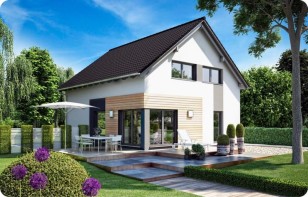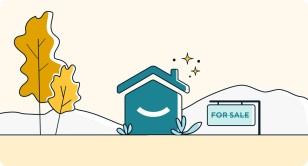Baukindergeld: Extra benefit for new homeowners with kids
Baukindergeld is a state subsidy (12K euros over 10 years per child) for families and single parents who want to buy their first home in Germany.Updated on July 15, 2025

- What is Baukindergeld, and what requirements must be met?
- What is supported?
- Who is supported?
- These conditions apply to the Baukindergeld
- For this, you can use the Baukindergeld
- Use the Baukindergeld for unscheduled repayment
- Putting a Baukindergeld in a bank account
- Use the Baukindergeld to pay off an additional loan
- How does the application and payment process work?
In this article, we explain what the requirements for the Baukindergeld are, how the application process works, and what deadlines apply.
Alas is no longer available. Other subsidies are still available, notably the KFW 124 program for first home buyers and other programs for energy-efficient properties.
What is Baukindergeld, and what requirements must be met?
As already mentioned, the Baukindergeld is a subsidy for families and single parents provided by the German government. It is intended to support the purchase of owner-occupied real estate. The German government is providing a total of 10 billion euros for the “Baukindergeld” program, although around three-quarters of the available funds have already been used up.
Applicants receive a total of 12,000 euros per child, but the Baukindergeld is paid out annually. That means that you will receive 1,200 euros per child for ten years. Applications for the Baukindergeld can only be made directly to the Kreditanstalt für Wiederaufbau (KfW).
Unlike the other KfW loans and grants, however, the Baukindergeld is only applied for after you and your family have moved into the house. After moving in, you have six months to apply.
Please note: The eligibility requirements state that you must have signed your purchase agreement or received your building permit between 01/01/2018 and 03/31/2021 (deadline A). You apply for the Baukindergeld after you have moved in. You have a total of 6 months to do this (deadline B). The last day on which families and single parents can apply for Baukindergeld is 12/31/2023 (deadline C). Then, the subsidy period ends.
Example: You bought a house and signed the notarized purchase contract on 06/22/2020 (deadline A for the purchase contract met). You rebuild with a lot of your own work and move in on 09/14/2022. You submitted the application for the building subsidy 2 weeks later, on 09/28/2022 (deadline B for the application within 6 months after moving in met; deadline C for the very last application day, 12/31/2023 met).
What is supported?
The Baukindergeld subsidizes parents and single parents who either build or buy a house and move in themselves, who buy an apartment and move in themselves, or who buy their rented residential property and continue to live in the apartment or house.
As you can see, one of the most important conditions for the Baukindergeld is that you and your family live in the property yourself.
Who is supported?
KfW supports families with children and single parents who meet the following requirements:
There are children under the age of 18 living in your household for whom you or your partner receive child benefits. By the way, you will receive Baukindergeld for the entire payment period, even if your child turns 18 before the end of the payment period. The decisive factor is that the child is under 18 on the day of application.
Your signed notarized purchase contract or building permit is dated between 01/01/2018 and 03/31/2021.
Your new home is your only residential property in Germany as of the qualifying date.
Your household income is a maximum of 90,000 euros per year for one child plus 15,000 euros for each additional child.
Your new home or condominium is located in Germany.
Your nationality is not relevant.
These conditions apply to the Baukindergeld
The amount of the Baukindergeld depends on the number of children and the maximum household income. The following table explains how much the Baukindergeld is.

As can be seen from the table, for each additional child, the maximum household income increases, and the subsidy per year increases by 1,200 euros, or the total subsidy amount increases by 12,000 euros in ten years.
There is no limit to the number of children for whom you can receive the subsidy.
The household income is the average income of the penultimate and penultimate years before the application was submitted.
For example: For applications in 2021, your income from 2019 and 2018 applies. Just look at your income tax statements.
For this, you can use the Baukindergeld
Since the Baukindergeld can only be applied for after you have moved in and is paid out per year, you cannot use it as a down payment or equity capital for your mortgage.
However, there are other ways to make good use of the subsidy. Below, we give you a brief overview of three possible uses.
Use the Baukindergeld for unscheduled repayment
Even though unscheduled repayments (“Sondertilgungen”) are very popular but often also an overrated option, you can use the Baukindergeld to pay off your mortgage faster.
If you regularly make unscheduled repayments with the Baukindergeld (1,200 euros per year per child, 2,400 euros per year for two children), the remaining debt on your mortgage will fall more quickly. This saves you interest costs over the years.
Example: You buy a property for 250.00 Euro. To do this, you take out a mortgage of 200,000 euros with a fixed interest rate of 15 years and a repayment rate of 2 percent.
Without Baukindergeld, you'll be paying off the mortgage for about 28 years. The interest costs amount to over 37,700 euros. With one child (12,000 euros in ten years), the interest costs fall by around 1,700 euros and the term is reduced by more than 1.5 years. With two children (24,000 euros in ten years), you save more than 3,500 euros in interest. The loan term is reduced by 3.5 years.
Putting a Baukindergeld in a bank account
If interest rates rise significantly over the life of your mortgage, say to 3 to 4 percent, it's a good idea to make additional repayments on your mortgage. But not with an unscheduled repayment.
At that point, you should put the Baukindergeld in a bank account — a time deposit account that runs until the end of the fixed-rate period. This is because the bank pays a higher interest rate (2 to 3%) than the interest rate you save on your mortgage (about 1%). At the end of the fixed interest period, you take the money from the bank and use it to reduce your loan.
Use the Baukindergeld to pay off an additional loan
If you have taken out an additional loan to increase your affordability or to cover the additional purchase costs, you can use the Baukindergeld to pay off this loan more quickly.
Such a personal loan usually has quite high interest rates and high monthly payments. You can include the building allowance as a regular unscheduled repayment. This way, you pay off the loan faster, the installment for this loan is eliminated sooner, and you save interest costs.
How does the application and payment process work?
As already described, you can only apply for the Baukindergeld after you have moved in. As proof of moving in, you need a registration confirmation that you receive from the local authority.
Six months after moving in, you have to apply online at the KfW portal. Please note that all household members must be registered in the new property at the time of application. If you buy the property you already live in, you apply within 6 months after you have signed the purchase contract.
After submitting your application, you will receive an application confirmation, which you can find in the KfW portal. Now, you have to prove your identity — either online via video identification or with “Postident” at a Deutsche Post branch.
Once your application has been confirmed, you have three months from this point to upload your documents to the KfW portal. You will need the following documents:
Income tax assessment notices (“Einkommensteuerbescheide”)
Registration confirmation (“Meldebestätigung”)
Land register statement (“Grundbuchauszug”)
Purchase contract or building permit (“Kaufvertrag” oder “Baugenehmigung”)
As soon as KfW has completed its review of your documents, you will be informed of this by e-mail and via the KfW portal. If the review of your documents is successful, they will pay the grant to your account.
From the first payment, you will receive 1,200 euros per child for ten years if you live in your home for that long.
Please note: If you sell or rent out the house or apartment, you are required to notify KfW immediately. You will then no longer meet the eligibility requirements, which means that the annual payments will be stopped.


